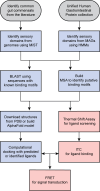Framework for exploring the sensory repertoire of the human gut microbiota
- PMID: 38757952
- PMCID: PMC11237719
- DOI: 10.1128/mbio.01039-24
Framework for exploring the sensory repertoire of the human gut microbiota
Abstract
Bacteria sense changes in their environment and transduce signals to adjust their cellular functions accordingly. For this purpose, bacteria employ various sensors feeding into multiple signal transduction pathways. Signal recognition by bacterial sensors is studied mainly in a few model organisms, but advances in genome sequencing and analysis offer new ways of exploring the sensory repertoire of many understudied organisms. The human gut is a natural target of this line of study: it is a nutrient-rich and dynamic environment and is home to thousands of bacterial species whose activities impact human health. Many gut commensals are also poorly studied compared to model organisms and are mainly known through their genome sequences. To begin exploring the signals human gut commensals sense and respond to, we have designed a framework that enables the identification of sensory domains, prediction of signals that they recognize, and experimental verification of these predictions. We validate this framework's functionality by systematically identifying amino acid sensors in selected bacterial genomes and metagenomes, characterizing their amino acid binding properties, and demonstrating their signal transduction potential.IMPORTANCESignal transduction is a central process governing how bacteria sense and respond to their environment. The human gut is a complex environment with many living organisms and fluctuating streams of nutrients. One gut inhabitant, Escherichia coli, is a model organism for studying signal transduction. However, E. coli is not representative of most gut microbes, and signaling pathways in the thousands of other organisms comprising the human gut microbiota remain poorly understood. This work provides a foundation for how to explore signals recognized by these organisms.
Keywords: amino acids; gut microbiome; receptors; signal transduction.
Conflict of interest statement
The authors declare no conflict of interest.
Figures






Similar articles
-
Metage2Metabo, microbiota-scale metabolic complementarity for the identification of key species.Elife. 2020 Dec 29;9:e61968. doi: 10.7554/eLife.61968. Elife. 2020. PMID: 33372654 Free PMC article.
-
A new genomic blueprint of the human gut microbiota.Nature. 2019 Apr;568(7753):499-504. doi: 10.1038/s41586-019-0965-1. Epub 2019 Feb 11. Nature. 2019. PMID: 30745586 Free PMC article.
-
The Mouse Gastrointestinal Bacteria Catalogue enables translation between the mouse and human gut microbiotas via functional mapping.Cell Host Microbe. 2022 Jan 12;30(1):124-138.e8. doi: 10.1016/j.chom.2021.12.003. Epub 2021 Dec 30. Cell Host Microbe. 2022. PMID: 34971560 Free PMC article.
-
Intracellular glycogen accumulation by human gut commensals as a niche adaptation trait.Gut Microbes. 2023 Jan-Dec;15(1):2235067. doi: 10.1080/19490976.2023.2235067. Gut Microbes. 2023. PMID: 37526383 Free PMC article. Review.
-
Sensory Repertoire of Bacterial Chemoreceptors.Microbiol Mol Biol Rev. 2017 Oct 25;81(4):e00033-17. doi: 10.1128/MMBR.00033-17. Print 2017 Dec. Microbiol Mol Biol Rev. 2017. PMID: 29070658 Free PMC article. Review.
Cited by
-
Bacterial amino acid chemotaxis: a widespread strategy with multiple physiological and ecological roles.J Bacteriol. 2024 Oct 24;206(10):e0030024. doi: 10.1128/jb.00300-24. Epub 2024 Sep 27. J Bacteriol. 2024. PMID: 39330213 Free PMC article. Review.
-
Thermal shift assay to identify ligands for bacterial sensor proteins.FEMS Microbiol Rev. 2025 Jan 14;49:fuaf033. doi: 10.1093/femsre/fuaf033. FEMS Microbiol Rev. 2025. PMID: 40720780 Free PMC article. Review.
-
Effects of water-insoluble wheat bran-fraction powder on disease activity and caecal microbiota in dextran sodium sulphate-induced inflammatory bowel disease mouse model.Mol Biol Rep. 2024 Nov 1;51(1):1112. doi: 10.1007/s11033-024-10045-2. Mol Biol Rep. 2024. PMID: 39485667
-
Interplay between chemotaxis, quorum sensing, and metabolism regulates Escherichia coli-Salmonella Typhimurium interactions in vivo.PLoS Pathog. 2025 May 2;21(5):e1013156. doi: 10.1371/journal.ppat.1013156. eCollection 2025 May. PLoS Pathog. 2025. PMID: 40315408 Free PMC article.
-
Structural and functional diversity of sensor domains in bacterial transmembrane receptors.Trends Microbiol. 2025 Jul;33(7):796-809. doi: 10.1016/j.tim.2025.02.019. Epub 2025 Mar 21. Trends Microbiol. 2025. PMID: 40121131 Review.
References
MeSH terms
Grants and funding
LinkOut - more resources
Full Text Sources

